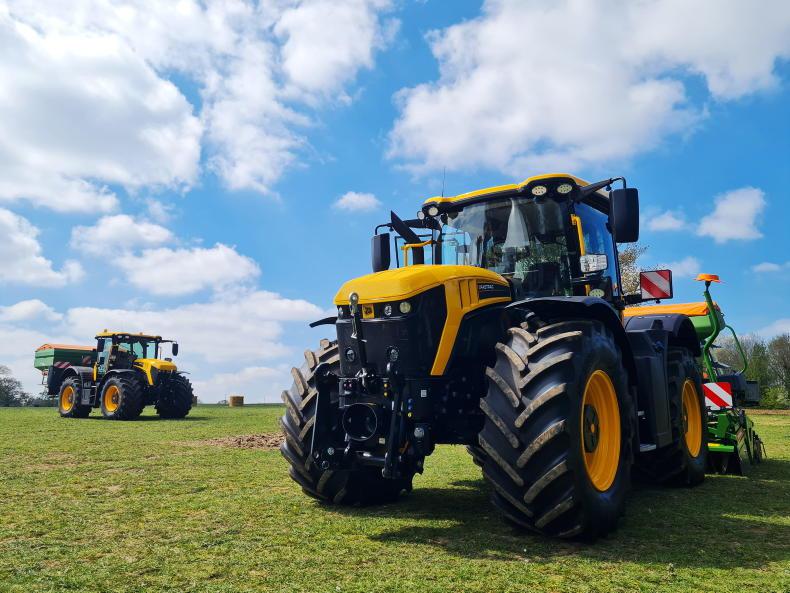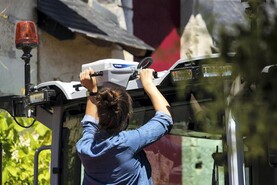The Irish Farmers Journal can exclusively reveal that a total of 416 ‘full’ RSA tractor tests have been carried out since testing first began in June 2018.
The pass rate has been improving year on year, until this year. In 2022, the pass rate peaked at 61%, the highest to date. However, this year, the pass rate dipped to 56%.
Over the test’s six-year existence, its average pass rate has risen to 52.2%, an improvement of 0.4% on the previous average.
The legislation requiring fast tractors to undergo a roadworthiness test, similar to that of an NCT for cars, was introduced in May 2018.
Brands
A total of 14 different brands of tractors have been tested to date. As you would expect, JCB is the most popular brand tested. Its high-speed Fastrac tractors account for one in four (25.6%) of all units tested to date.

The RSA state that the requirement of a fast tractor (design speed exceeding 40km/h) to be tested is based on its use.
John Deere is the second most popular brand tested, accounting for 19.3%. New Holland accounted for a further 16.7% of all tests to date. This means that the three brands combined have accounted for almost 62% of all tests carried out to date. The next in line were Fendt (8.7%) and Case IH (6.6%).
The Road Safety Authority (RSA) states that the requirement of a fast tractor (design speed exceeding 40km/h) to be tested is based on its use.
Any fast tractor which is used for a non-exempted activity (non-agricultural work) requires a certificate of roadworthiness (CRW).
Such examples of tractors required to be tested include: those involved in local authority work, the construction, quarrying, manufacturing or mining industries or road construction/roadworks.
‘Fast’ tractors will not have to be tested if it is being used for the purposes of agricultural, horticultural, forestry, farming or fishery activity, on the land where such activity takes place.
Eligible tractors are required to display a CRW on the vehicle’s windscreen. The tractor test mirrors the commercial vehicle roadworthiness test (CVRT) currently carried out on heavy commercial vehicles (HCVs), but has been modified to suit tractors.
Eligible tractors are required to be tested after they have reached their fourth birthday, and every second year after that. As with any CVRT, DOE or NCT vehicle test, the reading on the hour meter is recorded at the time of the test.
The law states that if a tractor is deemed to have failed dangerously, it cannot be driven out of the test centre. Similar to other vehicle tests, if the initial test is failed, the retest must be carried out within 21 days.
Where are the
tractors tested?
There are now 43 RSA approved test centres, which is five more than last year, across 21 counties throughout the country.
All of these centres are also heavy commercial vehicle (HCV) testing centres.
This year marks the first in which testing has now taken place across all 21 counties. Up to this year, Dublin was the outlier.
Kerry is leading the way in terms of the number of tests carried out to date, accounting for 13.6% of all tests.
This is followed by Mayo (9.6%) and Offaly (9%), meaning three counties combined accounted for over 32% of all tests.

Over the past six years of testing, steering linkage condition and speed discs have come out in the top five reasons of failure each year.
What are tractors failing on?
The test is broken down into seven stages – starting with braking equipment, then steering, on to visibility, lamps, reflectors and electrical equipment, axles, wheels, tyres and suspension, the chassis, cab and bodywork, safety restraints, locks, horn, speedometer and, finally, emissions/noise.
Over the past six years of testing, steering linkage condition and speed discs have come out in the top five reasons of failure each year.
Meanwhile, lights condition and operation, mechanical coupling and towing device and the transmission have also been among the most common failure items year on year.
Top five fail items in 2023 tests
1. Steering linkage condition.
2. Speed discs.
3. Windscreen washers.
4. Suspension.
5. Mechanical coupling and towing.

JCB is the most popular brand tested. Its high-speed Fastrac tractors accounts for one in four (25.6%) of all units tested to date.
The Irish Farmers Journal can exclusively reveal that a total of 416 ‘full’ RSA tractor tests have been carried out since testing first began in June 2018.
The pass rate has been improving year on year, until this year. In 2022, the pass rate peaked at 61%, the highest to date. However, this year, the pass rate dipped to 56%.
Over the test’s six-year existence, its average pass rate has risen to 52.2%, an improvement of 0.4% on the previous average.
The legislation requiring fast tractors to undergo a roadworthiness test, similar to that of an NCT for cars, was introduced in May 2018.
Brands
A total of 14 different brands of tractors have been tested to date. As you would expect, JCB is the most popular brand tested. Its high-speed Fastrac tractors account for one in four (25.6%) of all units tested to date.

The RSA state that the requirement of a fast tractor (design speed exceeding 40km/h) to be tested is based on its use.
John Deere is the second most popular brand tested, accounting for 19.3%. New Holland accounted for a further 16.7% of all tests to date. This means that the three brands combined have accounted for almost 62% of all tests carried out to date. The next in line were Fendt (8.7%) and Case IH (6.6%).
The Road Safety Authority (RSA) states that the requirement of a fast tractor (design speed exceeding 40km/h) to be tested is based on its use.
Any fast tractor which is used for a non-exempted activity (non-agricultural work) requires a certificate of roadworthiness (CRW).
Such examples of tractors required to be tested include: those involved in local authority work, the construction, quarrying, manufacturing or mining industries or road construction/roadworks.
‘Fast’ tractors will not have to be tested if it is being used for the purposes of agricultural, horticultural, forestry, farming or fishery activity, on the land where such activity takes place.
Eligible tractors are required to display a CRW on the vehicle’s windscreen. The tractor test mirrors the commercial vehicle roadworthiness test (CVRT) currently carried out on heavy commercial vehicles (HCVs), but has been modified to suit tractors.
Eligible tractors are required to be tested after they have reached their fourth birthday, and every second year after that. As with any CVRT, DOE or NCT vehicle test, the reading on the hour meter is recorded at the time of the test.
The law states that if a tractor is deemed to have failed dangerously, it cannot be driven out of the test centre. Similar to other vehicle tests, if the initial test is failed, the retest must be carried out within 21 days.
Where are the
tractors tested?
There are now 43 RSA approved test centres, which is five more than last year, across 21 counties throughout the country.
All of these centres are also heavy commercial vehicle (HCV) testing centres.
This year marks the first in which testing has now taken place across all 21 counties. Up to this year, Dublin was the outlier.
Kerry is leading the way in terms of the number of tests carried out to date, accounting for 13.6% of all tests.
This is followed by Mayo (9.6%) and Offaly (9%), meaning three counties combined accounted for over 32% of all tests.

Over the past six years of testing, steering linkage condition and speed discs have come out in the top five reasons of failure each year.
What are tractors failing on?
The test is broken down into seven stages – starting with braking equipment, then steering, on to visibility, lamps, reflectors and electrical equipment, axles, wheels, tyres and suspension, the chassis, cab and bodywork, safety restraints, locks, horn, speedometer and, finally, emissions/noise.
Over the past six years of testing, steering linkage condition and speed discs have come out in the top five reasons of failure each year.
Meanwhile, lights condition and operation, mechanical coupling and towing device and the transmission have also been among the most common failure items year on year.
Top five fail items in 2023 tests
1. Steering linkage condition.
2. Speed discs.
3. Windscreen washers.
4. Suspension.
5. Mechanical coupling and towing.

JCB is the most popular brand tested. Its high-speed Fastrac tractors accounts for one in four (25.6%) of all units tested to date.









 This is a subscriber-only article
This is a subscriber-only article










SHARING OPTIONS: